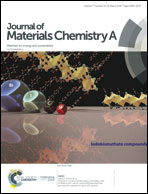Emission enhancement and bandgap retention of a two-dimensional mixed cation lead halide perovskite under high pressure†
Abstract
Two-dimensional (2D) lead halide perovskites are becoming attractive due to their exceptional stability and fine-tuning of optoelectronic properties compared to their 3D counterparts. Here, we systemically investigated the relationship between the structure and optical properties of 2D layered perovskite (C(NH2)3)(CH3NH3)2Pb2I7 under a high pressure. The emission intensity significantly increased as the pressure increased to 1.3 GPa, followed by a continuous reduction and disappearance at 7.0 GPa. Simultaneously, the bandgap first decreased, then increased, and gradually decreased again along with pressure elevation and was partially retainable after decompression due to structure recrystallization. The XRD result showed that the structure was stable up to 7.0 GPa and then gradually amorphized with local structure distortion. We speculated two distinct regimes of compression dominated by the alternating ordering of softer organic cation layers and less compressible inorganic octahedral layers. This work paves the way to investigate structure–property relationships in 2D perovskites and offers new strategies for further development of advanced perovskite devices.



 Please wait while we load your content...
Please wait while we load your content...